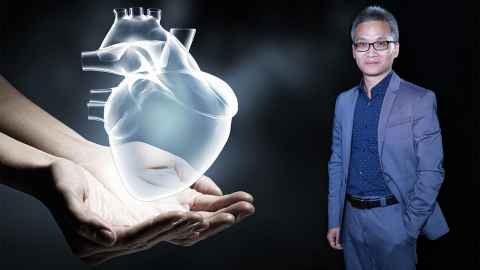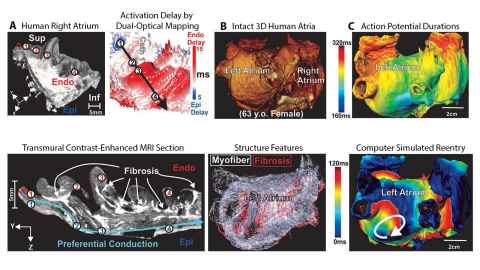Atrial fibrillation research
Atrial fibrillation (AF) is the most common sustained heart rhythm disturbance (arrhythmia). At present, 25% of the New Zealand population aged 40 and above will experience AF in their lifetime. Furthermore, as a result of the ageing population and the increasing incidence of heart failure, the prevalence of AF is projected to more than double in the following few decades, becoming a global epidemic. AF increases substantial morbidity and mortality. However, treatment for more stubborn types of AF remains suboptimal.
Dr Jichao Zhao is a Principal Investigator (PI) and leads the team at ABI that aims to improve our understanding of AF, and to investigate effective strategies for AF treatment by combining novel computational approaches (signal/structural analysis, computer models and machine learning) with structural imaging, experimental mapping and clinical studies.

Recent collaboration with overseas researchers at Ohio has made it possible for Dr. Zhao to study the intact human hearts directly to illustrate the roles of human atrial structure and function in AF [1-3] and improve our understanding of the human sino-atrial node (SAN).

Dr Zhao also leads a contrast-enhanced MRI study of patients with AF. His team has developed novel machine learning approaches for analysing functional and structural data from patients to aid clinical diagnosis and targeted treatment. [4-5] Finally, his team has developed a robust rabbit model with metabolic syndrome to study the exact mechanism underlying the increased susceptibility to cardiac disease.
Currently, we have a couple of PhD/masters/postdoc positions open. Contact Dr Zhao if you are interested.
Key references
- J Zhao, BJ Hansen, Csepe, Lim, Wang, Bratasz, Powell, Simonetti, Higgins, Kilic, Mohler, Janssen, Weiss,Hummel, VV Fedorov, “Integration of high resolution optical mapping and 3D micro-CT imaging to resolve thestructural basis of atrial conduction in the human heart”. Circulation: A. & E. 8(6):1514-17, 2015.
- BJ Hansen, J Zhao, TA Csepe, BT Moore, N Li, LA Jayne, A Kalyanasundaram, P Lim, A Bratasz, KAPowell, OP Simonetti, RSD Higgins, A Kilic, PJ Mohler, PML Janssen, R Weiss, JD Hummel, VV Fedorov,"Atrial fibrillation driven by micro-anatomic intramural re-entry revealed by simultaneous sub-epicardial andsub-endocardial optical mapping in explanted human hearts." European heart journal 36, no. 35 (2015): 2390-2401.
- J Zhao, BJ Hansen, Y Wang, TA Csepe, LV Sul, A Tang, Y Yuan, N Li, A Bratasz, KA Powell, A Kilic, PJMohler, PML Janssen, R Weiss, OP Simonetti, JD Hummel, VV Fedorov, "Three‐dimensional integratedfunctional, structural, and computational mapping to define the structural ‘fingerprints’ of heart‐specific atrialfibrillation drivers in human heart ex vivo." Journal of the American Heart Association 6, no. 8 (2017):p.e005922.
- Z Xiong, T Liu, G Tse, M Gong, P Gladding, BH Smaill, M Stiles, A Gillis, J Zhao, “A machine learningaided systematic review and meta-analysis of the relative risk of atrial fibrillation in patients with diabetesmellitus.” Frontiers in Physiology, 9:835. doi: 10.3389/fphys.2018.00835, 2018.
- Z Xiong, VV Fedorov, X Fu, E Cheng, R Macleod and J Zhao, "Fully automatic left atrium segmentationfrom late gadolinium enhanced magnetic resonance imaging using a dual fully convolutional neuralnetwork." IEEE Transactions on Medical Imaging 38, no.2 (2018):515-524.
Contact
Jichao Zhao, PhD, FHRS, PI, Senior Research Fellow
Email: j.zhao@auckland.ac.nz
Phone: +64 9 923 6505